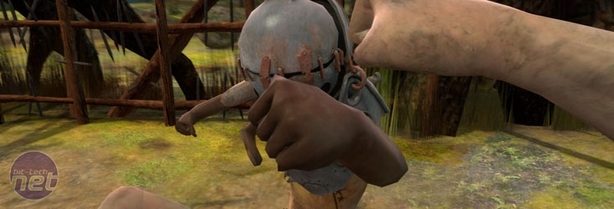First Person Brawler
bit-tech: Unlike a lot of games, Zeno Clash doesn’t immediately try to give the player some context to explain what the world they are in is like and what’s going on, simulating Ghat’s sense of panic at the start. Was this a deliberate design choice?Andres: Yes, we didn’t want to tell the story in the traditional linear fashion. We use a lot of racconto to give information about past events that modelled Ghat’s choices. That’s why players will feel lost and overwhelmed by the world from the start. The idea is to put the pieces together as the game progresses. The plot slowly then starts to make sense.
Some people have told us that they’ve played it twice, not just to get the achievements, but also to notice all the details from the story that didn’t click on the first run through. There are a lot of small details scattered around that talk about the world and the characters.
BT: Was there a specific reason you chose to make the game in Source engine or to set the game in the FPS perspective? It’s not a traditional method for making a brawler.
AB: The level of immersion has always been one the biggest strengths of a first-person game, because you feel like you’re playing through the eyes of the character. On the other hand combat is one of the most engaging actions a player can experience in a game, because it’s close and personal. The combination of the hand-to-hand combat and the immersion of a first-person game was the mix we were looking for. So with Zeno Clash we feel we have the best of both worlds.
Regarding the Source engine, one of the features that’s been most appreciated is the fantastic facial animation system. It’s key to have great facial animation if your enemies are generally standing right in front of you.
Also, with Source you have a whole set of tools that are very robust and versatile. We were concerned at first that we were going to be limited to building geometrical structures, when we required an organic and chaotic feel. The tools certainly allowed us to get the organic feel we were looking for. On several occasions people have asked us if we were using the Unreal Engine. A good engine should always allow you to branch away from the base game it was built on. If you look at Half Life or Left 4 Dead, Zeno Clash looks nothing like them, but they are all sustained on top of the same technology.
BT: How hard was it to get the melee system working in first-person? What sort of problems and implementations did you run up against?
AB: From a design point of view the combat mechanics were definitely our biggest challenge. There are no formulas for fun, so we pretty much worked with an iterative process. Our first builds had a lot of things going right, but also a lot of things going terribly wrong.
The first combat mechanics were very restrictive, because we were convinced that we had to take control from the player and let the combat system handle certain events for some combat actions. We were trying to avoid some excessive key configuration nightmares. I’ve spent literally five minutes configuring keys in some first-person shooters. When you have to press go prone, reload, use scope, steady your breath, aim and fire just to fire a sniper rifle it can be a little too much, don’t you think?
Getting the body awareness and blows to feel right was also crucial. We looked at Dark Messiah, Condemned, Breakdown and a few other titles for references. Our first tests consisted of prototyping combat sequences using a 3D package to test disorientation issues. We developed several videos from a first-person perspective where we animated sequences that involved severe movement of the player’s point of view. It’s true that during moments the player could become disoriented, but at the same time the videos were extremely fun to watch.
We eventually realized that a certain degree of disorientation is required to achieve immersion. Many shooters have included realistic camera movement during certain actions. Take Mirror’s Edge as an example; the player’s view is coherent with the player’s running, jumping and climbing. We also thought that at some key moments a higher level of disorientation is good. If you’re getting run over by a huge elephant man you’d expect to be disoriented while you’re being knocked down.

MSI MPG Velox 100R Chassis Review
October 14 2021 | 15:04












Want to comment? Please log in.